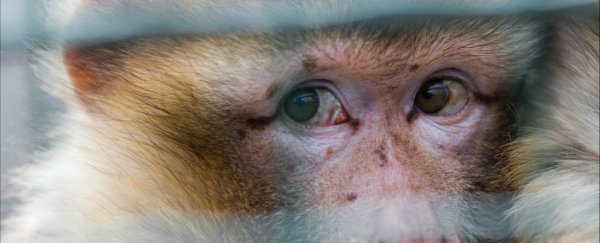An Italian surgeon has made unsubstantiated claims that his team has performed a head transplant on a monkey, and has successfully reconnected the severed spinal cords of mice - experiments he alleges are proof that a human head transplant is possible in the next two years.
According to a press release sent out at the start of the week, the results are due to be published in several papers across the journals Surgery and CNS Neuroscience & Therapeutics in the coming months, but these papers haven't been released or verified, which makes the motive behind telling the press about the work now - without any peer-reviewed evidence on hand - dubious as hell. Still, that didn't stop surgeon Sergio Canavero from releasing the graphic footage and images below.
If Canavero's name sounds familiar, that's because he was behind one of the most controversial science stories of last year. The Italian surgeon has been very vocal about the fact that he'll perform the first human head transplant (or more accurately, body transplant) by 2017, in an attempt to cure paralysis.
The premise of the surgery is that Canavero will essentially freeze the head and body, cut the patient's neck using a super-sharp blade, and then use a compound called polyethylene glycol, or PEG, to encourage the head to reattach to a new body and spinal cord.
His claims quickly drew skepticism from scientists and surgeons, with many arguing that the technique was impossible, and that the fate of the patient involved could be "considerably worse than death". The whole thing was so dubious that some were convinced the whole thing was a publicity stunt for Metal Gear Solid 5 (worryingly, it wasn't).
Still, Canavero somehow managed to recruit a volunteer for the surgery - paralysed Russian man Valery Spiridonov - as well as the support of Chinese surgeon, Xiaoping Ren, and the Vietnam-Germany Hospital in Hanoi. Now this latest press release, as well as a recorded Skype conversation with Spiridonov that's been released to the media, below, would suggest things are moving along quickly.
"A full monkey head transplant has been successfully accomplished by Ren's group in China with the goal of testing cross-circulation and hypothermia as an effective neuroprotective strategy," the press release said. "The first studies on human cadavers have already begun in China and will be expanded shortly."
Again, we need to make it clear that these claims should be taken with a big pinch (if not an entire shaker full) of salt, because no one has been able to back them up as yet - both New Scientist and Motherboard have tried unsuccessfully to access the journal articles - but according to Canavero, the monkey in question survived "perfectly without injury" for 20 hours before being euthanised for ethical reasons.
In the Skype conversation, Canavero shares photos of the monkey head transplant, as well as video footage of the mouse experiment, which shows mice moving their legs, somewhat awkwardly, after having their spinal cords severed and reattached using PEG. Canavero signs off with a somewhat bizarre callout to Russian billionaires and Mark Zuckerberg for funding.
Michael Sarr, editor of the journal Surgery and a surgeon at the Mayo Clinic in Rochester, told both New Scientist and Motherboard that the journal is in the process of editing Canavero's articles for publishing, but that Canavero had released the information too soon, without his knowledge.
He also insists that Surgery doesn't support the head transplant concept. "As an editor of a scientific journal, I don't want to be sensationalist, but I do want to point out that there may be a new approach to spinal cord paralysis due to spinal cord injuries," Sarr told Victoria Turk and Jason Koebler at Motherboard.
"What we're going to do, there's going to be a preface written by myself and my co-editor, and we're going to say before you start reading this, here's why we're interested in this topic. It's not because of the head transplantation, it's because they are claiming to have found a way to regrow the nerves."
Arthur Caplan, a bioethicist at New York University School of Medicine, remains skeptical. "When it gets published in a peer-reviewed journal I'll be interested," he told New Scientist. "I think the rest of it is BS."
He also questioned Canavero's decision to perform a head transplant rather than simply use his technique to help heal the spines of the hundreds of thousands of patients that currently suffer from spinal cord injury. "It's like saying I want to fly to the next galaxy when it would be nice to set up a colony on Mars, and I think about the same odds," said Caplan.
But if nothing else, this latest release shows that Canavero has his eyes fixed firmly on the prize, and that the plan for a human head transplant is steaming along, whether or not anyone else thinks that's a good idea.
If nothing else, let's hope that the research provides us with something that researchers have been pursuing for decades - a way to heal damaged spinal cords. "We proved without a hint at doubt that what the critics said - that the spinal cord could not be reconstructed," Canavero told Motherboard. "They were wrong, we were right."

